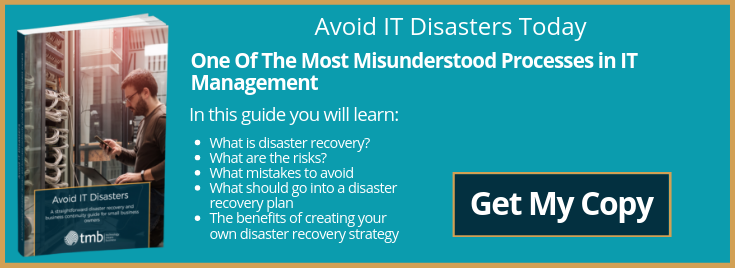What Is The Difference Between Backup And Disaster Recovery Solutions?
Backups and disaster recovery are terms that are often used in the same breath by managed IT providers, which glosses over the fact that there are differences between the two. Both are important for SMEs and there are some overlaps, but here is a breakdown of what each does, and how you can benefit from it!
Disaster Recovery And Backups
A disaster recovery strategy aims to restore your operating systems, software, and data in a workable format should something happen to your business – this ‘something’ being a flood, fire, cyberattack, or another disastrous event that knocks out your IT infrastructure.
The point of disaster recovery is to restore full operational efficiency as quickly as possible, and in practice this isn’t simply a matter of turning the clock back to how your systems were one minute before the disaster. Attempting to do this can actually create greater problems for your users and customers. Therefore, a disaster recovery plan aims to re-establish your infrastructure in a step-by-step plan based on your organisational priorities. This ensures your IT infrastructure is re-established in the correct order, and avoids potential clashes and incompatibilities between components and software.
A good disaster recovery plan takes your core business functions into account and focuses on getting the most essential services up and running first, to minimise potential lost revenue.
So, How Do Backups Fit In With Disaster Recovery?
Without a backup there is nothing for a disaster recovery plan to work with.
A backup is simply a copy of a file or application at a specific point in time, held on a spare hard drive, a server in your back office, or a cloud storage service. The time at which the backup was made is your recovery point, so if you make daily backups at 6 PM each evening and someone spills coffee on your server at 1 PM the next day, you can restore your systems to how they were at the end of the previous day but you’ll lose a morning’s work. This can pose serious problems, especially in busy remote teams, which is all backup strategies strive to make the recovery point as close in time as possible to the present. We recommend 24-hour cloud backups that create a real-time rolling image of your data and apps that can be restored at any moment.
Backups include the raw data and files needed to enact a disaster recovery plan, but on its own, the backed up data is unusable. In the same way as you can’t simply upload a collection of HTML and image files and restore a website, a process must be followed to get your systems operating again efficiently. This is why most managed IT service plans include both backup and disaster recovery in a comprehensive service (although the services are sometimes available on their own).
Including Disaster Recovery And Backups In A Managed IT strategy
As we have seen, although disaster recovery and backups mean different things, they are most effective when combined together within a strategy. In this way, a managed IT supplier such as TMB can proactively safeguard your business revenues and crucial data – and help you rebuild quickly from the ground up, should this be required.
To find out more about our tailored support plans, please give one of our IT specialists a call today.
Image Source: Canva



